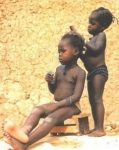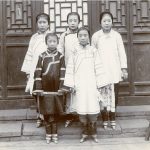This week older students start their research projects for the term, whilst younger students are doing the Timeline Activity. Our youngest students are thinking about the places where people live and can join together with older students as buddies to Build A Humpy together.
Foundation/Prep/Kindy to Year 3
 Students in stand-alone Foundation/Prep/Kindy classes (Unit F.3), or those in classes integrated with Year 1 (Unit F-1.3) are considering different types of homes this week. They will think about where the people in the stories from last week live and compare that to their own houses. They can consider how homes were different in the past and how our homes help us meet our basic needs. There is an option this week for these students to buddy with older students, especially those in Years 4, 5 and 6, to undertake the Building A Humpy activity together. In this activity students collect materials to build a replica Aboriginal humpy or shelter outside. Many teachers find that both senior primary and the younger students get a lot of benefit from helping each other with activities, enriching the learning experience. The Building a Humpy activity is one where the older students can assist the younger students with the physical requirements of building a humpy, whilst each group considers aspects of the activity relevant to their own studies, and comparing past ways of life to their own.
Students in stand-alone Foundation/Prep/Kindy classes (Unit F.3), or those in classes integrated with Year 1 (Unit F-1.3) are considering different types of homes this week. They will think about where the people in the stories from last week live and compare that to their own houses. They can consider how homes were different in the past and how our homes help us meet our basic needs. There is an option this week for these students to buddy with older students, especially those in Years 4, 5 and 6, to undertake the Building A Humpy activity together. In this activity students collect materials to build a replica Aboriginal humpy or shelter outside. Many teachers find that both senior primary and the younger students get a lot of benefit from helping each other with activities, enriching the learning experience. The Building a Humpy activity is one where the older students can assist the younger students with the physical requirements of building a humpy, whilst each group considers aspects of the activity relevant to their own studies, and comparing past ways of life to their own.
 Students in Years 1 (Unit 1.3), 2 (Unit 2.3) and 3 (Unit 3.3) are undertaking the Timeline Activity this week. This activity is designed to complement the concept of the number line from the Mathematics curriculum, whilst helping students to learn to visualise the abstract concepts of the past and different lengths of time between historical events and the present. In this activity students walk out a timeline, preferably across a large open space such as the school Oval, whilst attaching pieces of paper at intervals to a string. The pieces of paper refer to specific events in history (starting with their own birth years) and cover a wide range of events from the material covered this year. Teachers can choose from events in Australian and world history, covering 100s, 1000s and even millions of years, back to the dinosaurs. Teachers can also add their own events. Thus the details of the activity are able to be altered in different years to maintain student interest. Depending on the class, the issue of scale can be addressed in various ways. By physically moving their bodies, students will start to understand the lengths of time involved in examinations of History. This activity is repeated in increasing detail in higher years, to make sure that the fundamental concepts are absorbed by students over time.
Students in Years 1 (Unit 1.3), 2 (Unit 2.3) and 3 (Unit 3.3) are undertaking the Timeline Activity this week. This activity is designed to complement the concept of the number line from the Mathematics curriculum, whilst helping students to learn to visualise the abstract concepts of the past and different lengths of time between historical events and the present. In this activity students walk out a timeline, preferably across a large open space such as the school Oval, whilst attaching pieces of paper at intervals to a string. The pieces of paper refer to specific events in history (starting with their own birth years) and cover a wide range of events from the material covered this year. Teachers can choose from events in Australian and world history, covering 100s, 1000s and even millions of years, back to the dinosaurs. Teachers can also add their own events. Thus the details of the activity are able to be altered in different years to maintain student interest. Depending on the class, the issue of scale can be addressed in various ways. By physically moving their bodies, students will start to understand the lengths of time involved in examinations of History. This activity is repeated in increasing detail in higher years, to make sure that the fundamental concepts are absorbed by students over time.
Years 3 to 6
 Students in Years 3 to 6 are starting their term research projects on Australian history this week. Students in Year 3 (Unit 3.7) concentrate on topics from the history of their capital city or local community. Suggested topics are included for Brisbane, Melbourne, Sydney, Adelaide, Darwin, Hobart, Perth and Canberra. Teachers can substitute their own topics for a local community study. Students will undertake a Scientific Investigation into an aspect of their chosen research project and will produce a Scientific Report. It is recommended that teachers supplement the resources provided with old photographs, books, newspapers etc, many of which can be accessed online, to provide the students with extra material for their investigation.
Students in Years 3 to 6 are starting their term research projects on Australian history this week. Students in Year 3 (Unit 3.7) concentrate on topics from the history of their capital city or local community. Suggested topics are included for Brisbane, Melbourne, Sydney, Adelaide, Darwin, Hobart, Perth and Canberra. Teachers can substitute their own topics for a local community study. Students will undertake a Scientific Investigation into an aspect of their chosen research project and will produce a Scientific Report. It is recommended that teachers supplement the resources provided with old photographs, books, newspapers etc, many of which can be accessed online, to provide the students with extra material for their investigation.

Students in Year 4 (Unit 4.3) will be focusing on Australia in the period up to and including the arrival of the First Fleet and the early colonial period. OpenSTEM’s Understanding Our World® program encompasses the whole Australian curriculum for HASS and thus does not simply rely on “flogging the First Fleet to death”! There are 7 research themes for Year 4 students: “Australia Before 1788”; “The First Fleet”; “Convicts and Settlers”; “Aboriginal People in Colonial Australia”; “Australia and Other Nations in the 17th, 18th and 19th centuries”; “Colonial Children”; “Colonial Animals and their Impact”. These themes are allocated to groups of students and each student chooses an individual research topic within their groups themes. Suggested topics are given in the Teacher Handbook, as well as suggested resources.

Year 5 (Unit 5.3) students focus on the colonial period in Australia. There are 9 research themes for Year 5 students. These are: “The First Fleet”; “Convicts and Settlers”; “The 6 Colonies”; “Aboriginal People in Colonial Australia”; “Resistance to Colonial Authorities”; “Sugar in Queensland”; “Colonial Children”; “Colonial Explorers” and “Colonial Animals and their Impact”. As well as themes unique to Year 5, some overlap is provided to facilitate teaching in multi-year classes. The range of themes also allows for the possibility of teachers choosing different themes in different years. Once again individual topics and resources are suggested in the Teacher Handbook.
 Year 6 (Unit 6.3) students will examine research themes around Federation and the early 20th century. There are 8 research themes for Year 6 students: “Federation and Sport”; “Women’s Suffrage”; “Aboriginal Rights in Australia”; “Henry Parkes and Federation”; “Edmund Barton and Federation”; “Federation and the Boer War”; “Samuel Griffith and the Constitution”; “Children in Australian History”. Individual research topics and resources are suggested in the Teachers Handbook. It is expected that students in Year 6 will be able to research largely independently, with weekly guidance from their teacher. OpenSTEM’s Understanding Our World® program is aimed at developing research skills in students progressively, especially over the upper primary years. If the program is followed throughout the primary years, students are well prepared for high school by the end of Year 6, having practised individual research skills for several years.
Year 6 (Unit 6.3) students will examine research themes around Federation and the early 20th century. There are 8 research themes for Year 6 students: “Federation and Sport”; “Women’s Suffrage”; “Aboriginal Rights in Australia”; “Henry Parkes and Federation”; “Edmund Barton and Federation”; “Federation and the Boer War”; “Samuel Griffith and the Constitution”; “Children in Australian History”. Individual research topics and resources are suggested in the Teachers Handbook. It is expected that students in Year 6 will be able to research largely independently, with weekly guidance from their teacher. OpenSTEM’s Understanding Our World® program is aimed at developing research skills in students progressively, especially over the upper primary years. If the program is followed throughout the primary years, students are well prepared for high school by the end of Year 6, having practised individual research skills for several years.

 Foundation/Prep/Kindy to Year 3
Foundation/Prep/Kindy to Year 3 Students in integrated Foundation/Prep/Kindy and Year 1 classes (Unit F-1.3), will also be examining stories from the
Students in integrated Foundation/Prep/Kindy and Year 1 classes (Unit F-1.3), will also be examining stories from the
 The rest of the 3rd term will be spent compiling a scientific report on an investigation into an aspect of Australian history. Students in Year 3 will choose a research topic from a list of themes concerning the history of their capital city. Students in Year 4 will choose from themes on
The rest of the 3rd term will be spent compiling a scientific report on an investigation into an aspect of Australian history. Students in Year 3 will choose a research topic from a list of themes concerning the history of their capital city. Students in Year 4 will choose from themes on
We purchased the soldering kit after our son did the Mirobot workshops at school. He loved the idea of soldering…
Helen, Parent